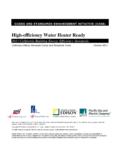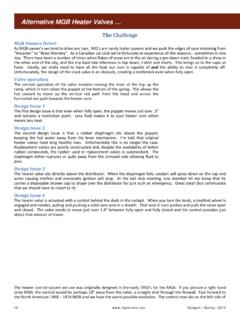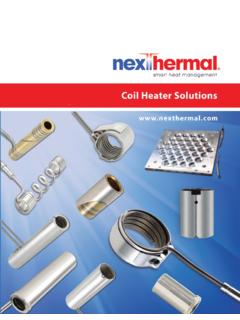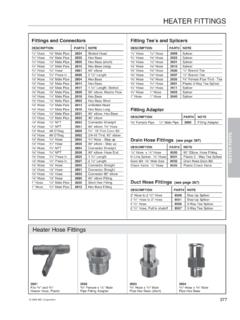Transcription of SIG Diesel Heater Manual 2011-2 - Dickinson Marine
1 Natural Draft Diesel Heater Operating and Installation Instruction Manual *KEEP THIS Manual FOR FUTURE REFERENCE*. Sig100, 120, 170, 180. ** Please read from beginning to end before installing and operating. Heater 's Serial #: _____. Quality Controlled by- Doug & Don Form# Issue#2 Sept 5th, 2012. 2. WARNINGS. - Do not operate this Heater unattended. - Turn off the Heater when refueling. - Do not burn gasoline. - When operating the Heater there MUST be an open fresh air vent. - Do not light a warm burner or it can result in an explosion. - Do not use a pressurized fuel tank. - Do not plug the overflow fitting. - Install a CO alarm.
2 - Follow ALL installation and operation procedures. 1. About a Natural Draft Diesel Heater A Sig Marine Diesel Heater has many advantages to other heating appliances. They can be run on no power but has a 12v draft assist fan to provide draft assistance. Our heaters are equipped with simple but reliable internal components including a gravity feed oil metering valve to a vaporizing oil burner where the fuel vaporizes by natural draft to burn a beautiful clean fire in the viewing combustion chamber. A vaporizing oil burner is designed to transform oil to a vapor state and then burn the vapor. Vaporizing is achieved by the oil reaching 465 F.
3 Once the oil is vaporized, it becomes flammable and an efficient and clean combustion is the result. To obtain a clean and efficient combustion, 3 factors must be in a balanced proportion. 1. Draft- the volume of air rising through the exhaust chimney. 2. Oxygen- replacement supply of fresh air. 3. Fuel- Input in proportion to the supply of draft and oxygen. Sig Marine Diesel heaters can also be calibrated to run kerosene (K) and stove oil (S). See Fuel Variations on Pg. 23. This code will be indicated on the side of the valve. A hot water coil can be factory installed or added later to also enjoy water heating from your Sig Marine Diesel Heater only on the Sig180 models.
4 Hot 3. water coils are available in a 1 turn coil to heat approx. 5-10 gallons of water. Hot water coils are also available in 2 turn coils to heat approx. 15-20. gallons of water. 2. Important Notes Here are some important notes to remember when installing a Sig Marine Diesel Heater : Mounting & location, 12v power hook-up, minimum 4ft and a maximum 10ft of chimney, the location of hole for the chimney & the fuel supply. VERY IMPORTANT: Unrestricted permanent fresh air inlet required to draw in outside air needed for correct operation. Fuel must be filtered and not exceed a pressure of 4 psi or a fuel pressure regulator must be used to avoid dangerous flooding.
5 A barometric damper must be installed to help regulate the draft. A. barometric gives you more control in the fuel to air mixture needed for correct operation. The valve controls the fuel whereas the fan increases the air and the barometric decreases the air (See Pg. 7/8). Install a CO alarm. 3. Ventilation Do NOT operate this Heater in an enclosed area without a permanent fresh air inlet designated for your Heater . This is required to draw in outside air for correct operation. To guarantee that fresh air is available for your Heater , good ventilation is essential. You MUST replace the air inside your boat at the same rate that the Heater is removing it.
6 The higher the Heater 's burning rate, the more air the Heater will require. If the air flow is blocked or restricted, the Heater will burn inefficiently, create soot, blow out and can even be a very dangerous health hazard. A permanently open fresh air inlet MUST be installed or dedicated to the Heater . This inlet must be at least 3" in diameter. Ducting to the Heater is also an option. 4. It is important to create and maintain a positive pressure inside the boat. High winds can draw air out from the boat and thus create a negative pressure. This condition can result in down drafts. Ensure that when you do have windows open that they do not create a suction effect in the cabin due to the window's position and the wind direction.
7 In a similar way, it is possible for the air intake on your engine to suck the air out of a cabin if it is not properly vented. Your Heater is a natural draft appliance and it creates its draft pressure like a chimney in a wood stove. The rising, heated air in the chimney pulls fresh air into the Heater as it rises up the chimney and exits the flue cap. The greater the draft pressure, the more able the Heater will be to resist strong winds, overcome flue elbows that inhibit draft and the hotter you will be able to get your Heater without sooting. A CO alarm should be installed in the boat. We also recommend the high heat shut-off kits available through us.
8 4. How Does the Chimney affect the Heater ? The Heater does not create the draft for a natural draft appliance to operate; it is the chimney that creates the draft for operation. The purpose of a chimney is to take the combustion products (smoke and gasses) from the appliance to the atmosphere outside your boat, and at the same time, to draw air in for combustion into the appliance. This movement of combustion air and exhaust is called draft. In essence, it is the difference in pressure between the air inside the chimney flue and the outside air that creates this movement. Warmer, lighter gases in the flue will move upward.
9 To keep the pressure conditions favorable, we need a tall column of warm air inside the chimney, and cooler air outside. The warm air will tend to rise, drawing the exhaust from the appliance out. As air exits the chimney, fresh air for combustion is drawn into the appliance. The stronger the upward draft in the chimney the more likely you won't experience downdraft. Important Factors of the Chimney Since draft is a measure of pressure, chimney draft is affected by pressure conditions in the boat. Several factors come into play: 1. Adequate air. First, there must be adequate air movement into the boat to make up for the air exiting through the chimney.
10 If the boat is very tightly insulated, the volume of air drawn up the flue will exceed 5. the volume of air entering the boat, and the boat will gradually become depressurized. With lower pressure in the boat than outside, there will be a tendency for air to be drawn back into the boat from all available openings including down the chimney. 2. Air movement in the boat. Second, air movement in the boat must not interfere with the chimney. As air flows out through the one window, air is drawn from another to replace it. This is called the stack effect, since the boat acts like a stack, or chimney. If the stack effect is powerful enough, it will overcome the chimney's upward draft and pull replacement air (and smoke) into the boat through the chimney.







